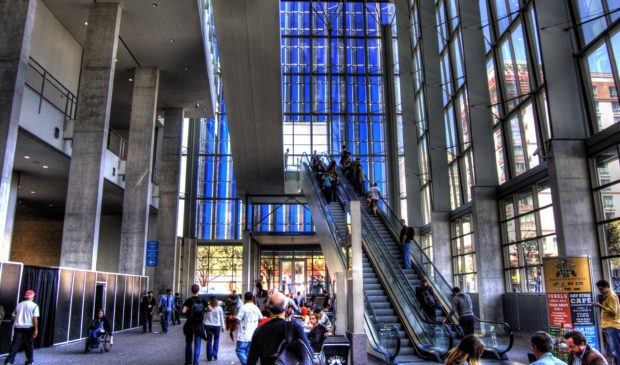Questions abound with convention center’s future up in the air
Wednesday, April 21, 2021 by
Chad Swiatecki With up being the only viable direction in which to significantly expand the Austin Convention Center, the deal structure and timeline for such a project appears to have gotten far more complicated.
Former City Council Member Jimmy Flannigan is now president of Austin Convention Enterprises, a public facilities corporation created to manage the city-owned Hilton Austin hotel adjacent to the convention center. Flannigan said the news this week that the city is abandoning a westward expansion of the facility means going vertical on the existing footprint. That would mean a prolonged reduction in available convention space, with hotel taxes paid by nearby convention-dependent hotels falling off as well.
Neither the city or convention center officials have relayed any plan for what comes next.
“The direction to head is up, and that was always on the list of options for that particular footprint that is owned by the city and is not constrained by (Capitol) view corridors, so you have the ability to go vertical,” Flannigan said. “The challenge with staying on the existing footprint is the construction time will reduce the available convention space. It also makes a very different assessment of who’s assuming the risk of construction, and the opportunity for (public-private partnerships) is not gone, but is different.”
Flannigan said the drastic reduction in hotel taxes caused by the Covid-19 pandemic likely impacted the budget for acquiring the three-and-a-half blocks west of the center, which were intended to include more convention space on the lower floors with a mix of space developed privately to make the proposed $1.2 billion expansion more financially feasible.
Once the western properties had been expanded, the plan approved by City Council would have had the existing convention center space dramatically remade to improve its public use and make it more accommodating to east-west foot traffic.
Flannigan said the city should still aim to make the site more pedestrian friendly, but doing so will mean less opportunity for public-private partnerships with developers to shoulder some of the financial burden.
“Even without the westward expansion, the opportunity is there to rebuild and reimagine the pedestrian scape,” he said. “What you lose by not going west is increased risk, a time period where hotels that were banking on a certain amount of convention space will now have a period where that (business) will be smaller because you have to tear a piece of it down when you build something new … it’s like how when TxDOT builds a highway while people are still driving on it, that makes the project more complicated and it will take longer.”
John Riedie, a member of the Tourism Commission who led an unsuccessful ballot proposal effort that would have required a public vote to OK financially ambitious capital projects for the center, said the city needs to solicit a new market study of the convention industry before conceiving a new expansion plan. He said most observers of the industry agree the facility needs significant work to remain competitive, and that an upward expansion could be a better option in the long run.
“It was a strange precedent to set to try to take four prime city blocks off of the tax rolls. By going back to the drawing board we can go with what the community needs and not just how the hotel industry leads the charge on the convention center,” he said. “Nobody disagrees that the current center needs a tech upgrade and an overhaul. If we can go vertical, that’s the best use of some of the most valuable real estate in the country.”
As part of the expansion proposal, hotel executives had signed on preliminarily to self-impose a 1 percent tax on revenues that would be used to provide resources to help the city’s homeless population. The process to create that tourism public improvement district has stalled with the onset of the pandemic, but Riedie said hoteliers should begin paying into it before any expansion plans are discussed.
“We also need to tell the hotel industry that they need to create the TPID to start providing resources for unhoused Austinites and then we’ll talk about expanding the convention center,” he said. “Once they create that TPID and put the resources where they said they would, that’s when we can have a conversation about a project that truly benefits the community and not just the hotel industry.”
The Austin Monitor’s work is made possible by donations from the community. Though our reporting covers donors from time to time, we are careful to keep business and editorial efforts separate while maintaining transparency. A complete list of donors is available here, and our code of ethics is explained here.
You're a community leader
And we’re honored you look to us for serious, in-depth news. You know a strong community needs local and dedicated watchdog reporting. We’re here for you and that won’t change. Now will you take the powerful next step and support our nonprofit news organization?










